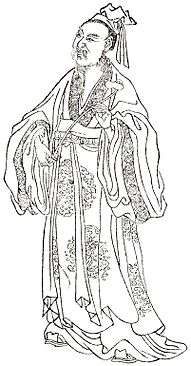Wang Xizhi

| Wang Xizhi | |||||||||||||||||||||
| Chinese | 王羲之 | ||||||||||||||||||||
|---|---|---|---|---|---|---|---|---|---|---|---|---|---|---|---|---|---|---|---|---|---|
| |||||||||||||||||||||
Wang Xizhi ([u̯ǎŋ ɕí.ʈʂɨ́]; Chinese: 王羲之; 303–361) was a Chinese writer and official who lived during the Jin Dynasty (265–420), best known for his mastery of Chinese calligraphy. Wang is generally regarded as the greatest Chinese calligrapher in history, and was a master of all forms of Chinese calligraphy, especially the running script. Emperor Taizong of Tang admired his works so much that the original Preface to the Poems Composed at the Orchid Pavilion was said to be buried with the emperor in his mausoleum.
In addition to the esteem in which he is held in China, he has been and remains influential in Japanese calligraphy.
Biography
Born in Linyi, Shandong, Wang spent most of his life in present-day Shaoxing, Zhejiang and Wenzhou. He learned the art of calligraphy from Lady Wei Shuo. He excelled in every script but particularly in semi-cursive script. Unfortunately, none of his original works remains today.

His most famous work is the Preface to the Poems Composed at the Orchid Pavilion, the introduction to a collection of poems written by a number of poets during a gathering at Lanting near the town of Shaoxing for the Spring Purification Festival. The original is lost, but the work survives in a number of finely traced copies, with the earliest and most well regarded copy being the one made between c. 627-650 by Feng Chengsu, and it is located in the Palace Museum in Beijing.
Wang Xizhi is particularly remembered for one of his hobbies, that of rearing geese. Legend has it that he learned that the key to how to turn his wrist whilst writing was to observe how geese moved their necks. There is a small porcelain cup depicting Wang Xizhi "walking geese" in the China Gallery of the Asian Civilisations Museum in Singapore. The other side of the cup depicts a scholar "taking a zither to a friend".
Wang Xizhi had seven children, all of whom were notable calligraphers. The most distinguished was his youngest son, Wang Xianzhi.
In 2010, a small Tang reproduction of one of Wang's calligraphy scrolls on silk with four lines was sold in China at an auction for ¥308 million RMB ($48 million).[1]
References
Footnotes
- ↑ "Rare Chinese calligraphy scroll fetches $46m at auction". BBC NEWS ASIA-PACIFIC. 22 November 2010. Retrieved August 29, 2011.
Works cited
- Knechtges, David R. (2014). "Wang Xizhi 王羲之". In Knechtges, David R.; Chang, Taiping. Ancient and Early Medieval Chinese Literature: A Reference Guide, Part Two. Leiden: Brill. pp. 1257–62. ISBN 978-90-04-19240-9.
- Li, Siyong, "Wang Xizhi". Encyclopedia of China (Chinese Literature Edition), 1st ed.
- Khoo Seow Hwa and Penrose, Nancy L, Behind the Brushstrokes: Tales from Chinese Calligraphy. Singapore: Graham Brash, 1993.
External links
| Wikimedia Commons has media related to: |
| Wikisource has original text related to this article: |
- Animation of Wang's Calligraphy AniGraphy by Marion Tzui Yan. broken link
- Wang Xizhi and his Calligraphy Gallery at China Online Museum
- Wang XiZhi's calligraphy
- Selections of Wang Xi Zhi by Professor Lu-sheng Chong
- Works by or about Wang Xizhi at Internet Archive
- Works by Wang Xizhi at LibriVox (public domain audiobooks)

- The Orchid Pavilion by Wang Xizhi.
